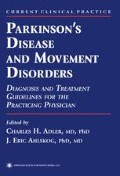Abstract
Chorea consists of continuous, unsustained, nonstereotyped movements of variably changing speed and direction that seemingly flow from one muscle group to another, thus giving the appearance of “dancing.” The differential diagnosis of chorea is large, consisting of many diseases and disparate causes (Table 25-1). Most causes of chorea are hypothesized to involve basal ganglia dysfunction. Physiologically, hypoactivity in the subthalamic nucleus and medial pallidum is thought to correlate with chorea.
Access this chapter
Tax calculation will be finalised at checkout
Purchases are for personal use only
Preview
Unable to display preview. Download preview PDF.
Selected Reading
Caviness JN, Muenter MD. An unusual cause of recurrent chorea. Mov Disord 1991; 6: 355–357.
Hardie RJ, Pullon HWH, Harding AE, Owen JS, Pires M, Daniels GL, Imai Y, Misra VP, King RHM, Jacobs JM, TippEn P, Duchen LW, Thomas PK, Marsden CD. Neuroacanthocytosis. A clinical, haematological and pathological study of 19 cases. Brain 1991; 114; 13–49.
Hayden MR, Bloch M, Wiggins S. Psychological effects of predictive testing for Huntington’s disease, in Behavioral Neurology of Movement Disorders ( Weiner WJ, Lang AE, eds), Raven Press, New York, 1995, pp. 201–210.
Lance JW. Familial paroxysmal dystonic choreoathEnosis and its differentiation from related syndromes. Ann Neurol 1977; 2: 285–293.
Lee MS, Marsden CD. Movement disorders following lesions of the thalamus or subthalamic region. Mov Disord 1994; 9: 493–507.
Paulson GW, Prior TW. Issues related to DNA testing for Huntington’s disease in symptomatic patients. Semin Neurol 1997; 17: 235–238.
Pulsinelli WA, Hamill RW. Chorea complicating oral contraceptive therapy. Case report and review of the literature. Am J Med 1978; 65: 557–559.
Shoulson I. On chorea. Clin Neuropharmacol 1986; : S85–99.
Weiner WJ, Lang AE. Movement Disorders: A Comprehensive Survey. Futura, Mount Kisco, New York, 1989, pp. 293–346, 569–597.
Editor information
Editors and Affiliations
Rights and permissions
Copyright information
© 2000 Springer Science+Business Media New York
About this chapter
Cite this chapter
Caviness, J.N. (2000). Huntington’s Disease and Other Choreas. In: Adler, C.H., Ahlskog, J.E. (eds) Parkinson’s Disease and Movement Disorders. Current Clinical Practice. Humana Press, Totowa, NJ. https://doi.org/10.1007/978-1-59259-410-8_25
Download citation
DOI: https://doi.org/10.1007/978-1-59259-410-8_25
Publisher Name: Humana Press, Totowa, NJ
Print ISBN: 978-1-61737-095-3
Online ISBN: 978-1-59259-410-8
eBook Packages: Springer Book Archive

